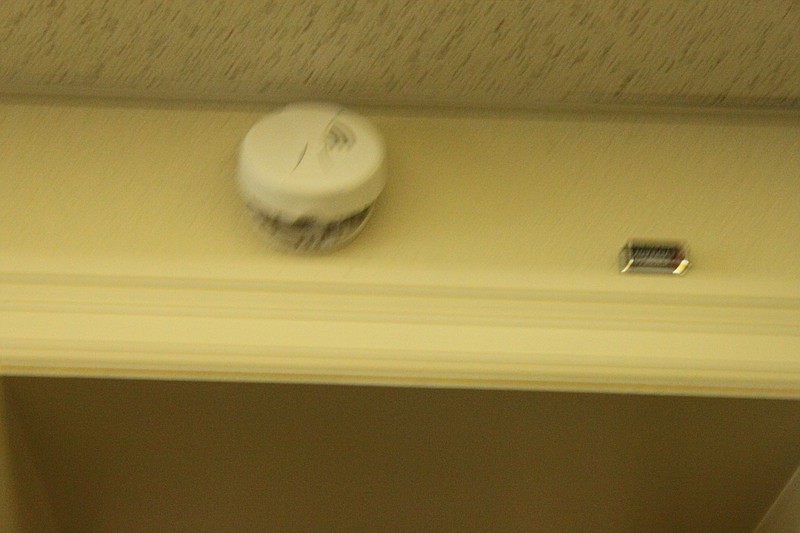Fire prevention week is just around the corner. While technology and access to fire safety tools have changed over the past decade, there are still factors that must be remembered to keep the public safe.
California Fire Department Fire Chief Allen Smith said the "number one most important thing" is to keep an eye on smoke detectors.
SMOKE DETECTORS
"Make sure you have one smoke detector in every sleeping area and every level of the house," Smith said. "Also place a smoke detector outside each sleeping area."
Over the years, it was advised to change batteries in smoke detectors once per year. Smith said this is no longer the case. Now, it is suggested to change smoke detector batteries twice per year. Luckily, Smith offers a useful reminder on this.
"Change your battery when you change your clock for daylight savings time," Smith said. "The biggest thing is to really make sure smoke detectors are maintained, because three out of five fire fatalities involve faulty smoke detectors. It may seem small, but $8 can really save a life."
BURNING
When it comes to autumn temperatures, bonfires often are part of the equation. They may be allowed within city limits, but there are restrictions to the controlled fires, Smith said.
"There's actually an open burn ordinance in town," Smith said. "The regulations say you have to have a fire in a barrel with a screen on it to keep it contained. There is a number of things you can't burn, twigs and things. But they can be taken to the California Yard Waste Recycling Center to be properly disposed of."
The California Yard Waste Recycling Center can be found north on Route O.
The city ordinance Smith mentioned can be found under Section 210.150: Burning Trash. The ordinance states:
"No person shall dispose of trash, refuse or leaves by open burning, or cause, allow or permit open burning of trash, refuse or leaves unless the same is authorized by Federal or State permit.
The following conditions shall apply to all permissible burning:
- Only natural products may be burned
- All burning must be in a container with a screen cover to keep burning debris confined
- All burning must be done during daylight hours
- All burning must be supervised by an adult at least 18 years of age.
The Fire Chief may prohibit all open burning at any time he/she determines that dry conditions make such burning hazardous."
There is yet another option to get rid of miscellaneous debris.
"The biggest factor, really, is to just not burn anything you may not be sure of," Smith said. "Do you live in town? Do you pay for trash services? You may as well use it, then."
CARBON MONOXIDE
Exposure to carbon monoxide can also be a factor as temperatures drop. One of the main sources of this colorless, odorless gas is home furnaces. One defining symptom of carbon monoxide poisoning, Smith said, is flu-like symptoms.
"If you think you may have a carbon monoxide leak, just call the fire department," Smith said. "We have a monitor that can detect the gas."
Furnaces, Smith said, are the number one suspect of carbon monoxide leaks. It is highly important homeowners and renters alike get their furnaces checked to verify the heating device works properly. A great way to ensure the quality of a furnace is to make sure it is up to code, according to the manufacturer's application use. Also, Smith advises to make sure there is a three-foot clearance around the furnace.
The Center for Disease Control website offers important information on carbon monoxide and prevention tips:
- Carbon monoxide is found in fumes produced from burning fuel in cars, small engines, stoves, lanterns, grills, gas ranges or furnaces. The fumes can build up indoors.
- Common side effects of carbon monoxide poisoning are headaches, dizziness, weakness, upset stomach, vomiting, chest pain and confusion.
The CDC also offers ways to avoid exposure to carbon monoxide:
- Invest in a battery-operated carbon monoxide detector. The average price for a detector is approximately $20.
- Do not use portable flameless chemical heaters indoors.
- Never use a portable gas camp indoors.
- When you buy gas equipment, only buy equipment with a seal from a national testing agency.
CHIMNEYS
Smith has been working with the California Fire Department for 35 years. During that time, he has seen quite a few changes in how people heat their dwellings. One action he has noticed is people are not burning with wood as much as they have in the past.
For those that do, chimneys are still a potential for danger, when it comes to fire safety. The running theme for fire safety seems to stand true with chimneys - to carefully maintain any devices that can cause a potential fire.
"Flue fires just go along with fireplaces," Smith said. "That's cause by creosote, which is a buildup in fires. It's caused by a buildup of wood, but especially green twigs that aren't seasoned."
The Chimney Safety Institute of America said most chimney fires go unnoticed. Several signs a chimney fire may have taken place can be found on its website:
- Signs of warped material of the damper, metal smoke chamber connector pipe or factor-built metal chimney.
- Discolored and/or distorted rain cap
- Cracks in exterior masonry
- Roofing material damaged from hot creosote.
Regular maintenance and observations of a changed environment are key factors in keeping up with fire safety and prevention. When in doubt, Fire Chief Smith said the California Fire Department is always happy to offer assistance with any updates or checks before a dangerous situation unfolds.

